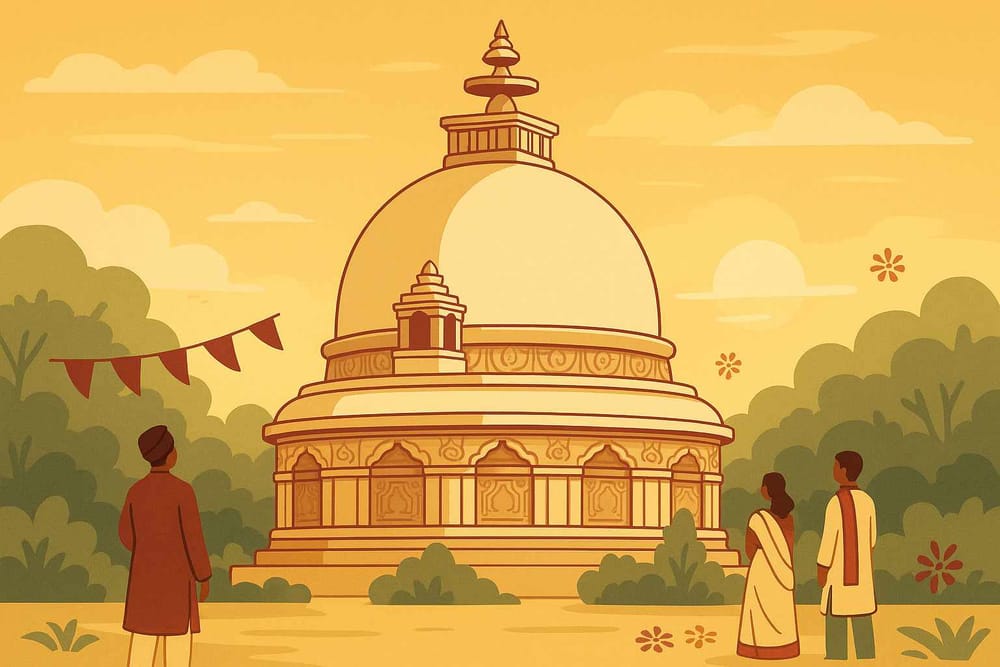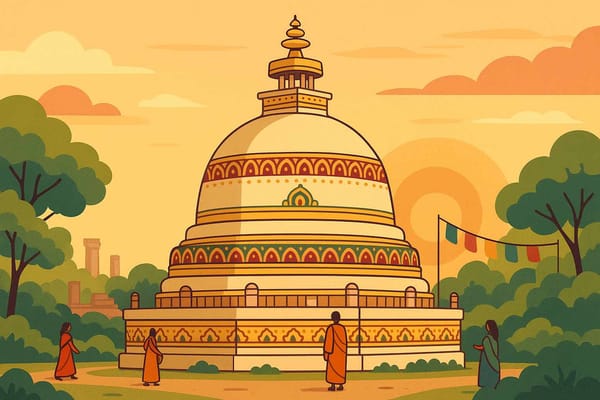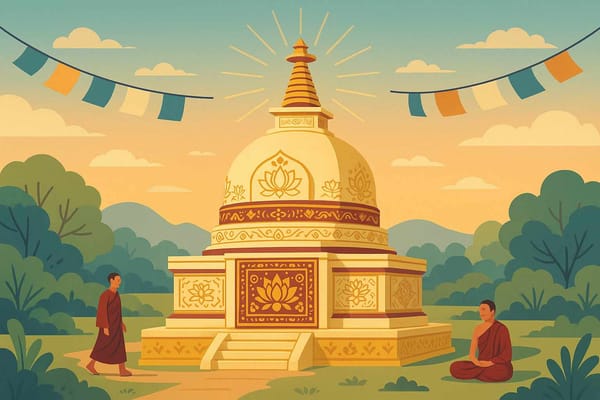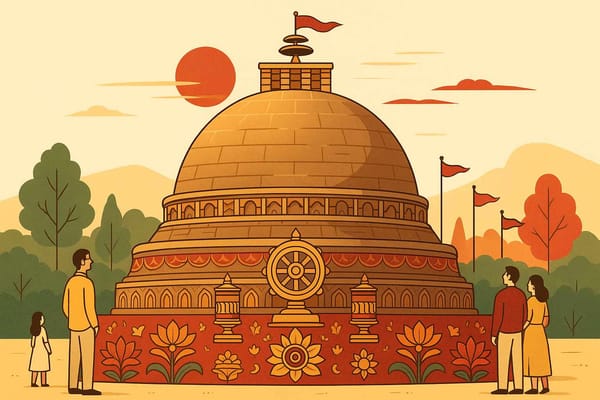
Dharmarajika Stupa- History's Journey Explores Mysteries
Have you ever felt the pull of a place you’ve never visited? A place where history isn't just in books, but whispers from the very stones themselves. For me, the Dharmarajika Stupa in Taxila, now in Pakistan, is one such place. It’s a silent witness to an era when the message of peace and Dharma travelled from India across the world, carried by one of our greatest emperors, Ashoka.
Nestled within the vast ruins of Taxila, a UNESCO World Heritage Site, this stupa is more than just an ancient monument. It’s a sacred space, a symbol of a time when spirituality, art, and learning flourished hand-in-hand. Let's take a walk back in time and listen to the stories this magnificent structure has to tell.
The Heart of Dharma: Why This Stupa is So Special
In Buddhist tradition, a stupa is not just a building; it is a representation of the Buddha's enlightened mind, a place for meditation and reflection. The very name, ‘Dharmarajika,’ gives us a clue to its origins. It means “Belonging to the King of Dharma,” a title lovingly given to Emperor Ashoka for his unwavering devotion to spreading Buddha's teachings. He was the 'Dharmaraja' who chose the path of peace over conflict.
Imagine pilgrims centuries ago, walking for miles just to be in its presence. The stupa was built to house something incredibly precious: sacred relics of the Buddha himself. These weren't just objects; they were a direct connection to his compassion and wisdom, making this a powerful pilgrimage site. It was a place where one could feel a sense of peace and get a little closer to the path of enlightenment.
A Journey Through Time: The Stupa's Rise and Tragic Fall
The story of the Dharmarajika Stupa begins in the 3rd century BCE. After the Kalinga war, a transformed Emperor Ashoka built this stupa, possibly over an even older one, to share the Buddha's relics. It became the heart of a bustling monastic complex in Taxila, a true crossroads of culture on the ancient Silk Road.
Over the centuries, it was expanded and cared for, especially during the Kushan era. But history, as we know, is not always kind. In the 5th century CE, the White Huns swept through the region, bringing devastation. King Mihirakula is said to have destroyed over a thousand Buddhist monasteries, and the Dharmarajika Stupa fell silent and was eventually abandoned. For centuries, its grandeur lay buried, its stories forgotten, until it was excavated by Sir John Marshall in 1913, bringing its legacy back to light.
Unlocking Ancient Secrets: The Mysteries Within its Walls
What treasures and secrets did this stupa hold? Archaeologists have uncovered fascinating clues that continue to intrigue scholars. A silver casket was found with an inscription revealing that in 78 CE, bone relics of the Buddha were placed there. This discovery gives us a priceless glimpse into the rituals and deep faith of the people of that time.
The stupa's design also tells a story of cultural exchange. You can see elements of Greco-Buddhist art, a beautiful blend of Indian spirituality and Hellenistic (Greek) artistic styles. This fusion of cultures reminds us that ancient India was a melting pot of ideas, much like the vibrant cities of our past, where history and myth often intertwine beautifully, a sentiment you can feel when exploring places like Udaipur's historic lanes. The exact origin of all the relics remains a subject of respectful debate, adding to the stupa's mystical charm.
More Than Just Bricks: The Stupa's Architectural Grandeur
The architecture of the Dharmarajika Stupa is a marvel of ancient engineering. It features a large, hemispherical dome built on a raised terrace, designed for 'parikrama' or circumambulation, a practice we still follow in our temples today. Staircases faced the four cardinal directions, welcoming devotees from all sides.
The core of the stupa is a complex structure of rubble and radiating walls, a testament to the skill of its builders. This architectural brilliance, dedicated to faith, is a common thread in our subcontinent's heritage. Every monument, whether a stupa in Taxila or a temple showcasing Vaishnava traditions like the Jagdish Temple, is a story set in stone, reflecting the deep devotion of its time.
A Legacy That Endures
Today, the Dharmarajika Stupa stands as a powerful reminder of our shared past and the universal values of compassion, peace, and the pursuit of knowledge. It connects us to an era of profound wisdom and cultural harmony. Walking among its ruins is not just a history lesson; it's an opportunity to reflect on teachings that are still so relevant in our lives.
It stands as a testament to Emperor Ashoka's vision and the vibrant spiritual life of ancient Taxila, reminding us of the enduring power of faith. It's a legacy we must treasure, ensuring its stories continue to inspire generations to come.
About Bhaktilipi
At Bhaktilipi, we believe that these stories of faith and history are our collective inheritance. We are a digital space dedicated to sharing timeless devotional literature and stories that connect with our modern lives. If you seek knowledge, inspiration, or a deeper connection with your roots, Bhaktilipi is here to walk that path with you.
Discover Our World
Learn more about our rich heritage, from the mysteries of ancient stupas to the essence of bhakti traditions, all presented in a simple, engaging way on Bhaktilipi.in.
Stay connected with our community for more such enriching content:
- Join us on Facebook: Follow our page for daily inspiration, stories, and updates that bring our traditions closer to you. Connect with us here.
- Follow us on Instagram: Experience the visual beauty of our culture through stunning images, short stories, and spiritual insights. Find us @bhakti_lipi.
- Subscribe on YouTube: Watch captivating narratives, listen to devotional music, and dive deep into the world of bhakti with our video content. Subscribe to our channel.
Subscribe to our newsletter and join our social media family to continue this beautiful journey into bhakti and tradition.
A passionate group of people dedicated to preserving India's knowledge of Dharma, Karma, and Bhakti for ourselves and the world 🙏.
Comments
Related in

Exploring the Ancient Dharmarajika Stupa- History Unfolds
Imagine a place where the very air seems to hold the echoes of ancient chants, a place where stones, weathered by centuries, tell a story of unwavering faith. This isn't just a fantasy; it's the living legacy of the Dharmarajika Stupa in Taxila, Pakistan. This isn&

Dharmarajika Stupa- History Reveals Significance
Some places in the world don't just exist in the present; they carry the whispers of centuries within their very stones. Imagine standing on ground that witnessed a great emperor's change of heart, a place where the message of peace was shaped into a magnificent structure.

Dharmarajika Stupa: Journey Through History
Have you ever stood in a place so ancient that you can almost hear the whispers of history in the wind? A place where the stones themselves seem to tell stories of emperors, monks, and seekers from centuries ago. One such place is the magnificent Dharmarajika Stupa, nestled near Taxila
